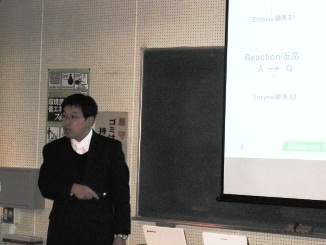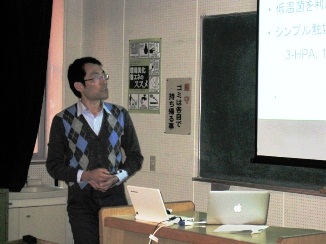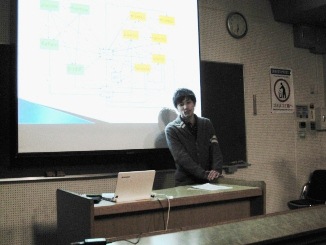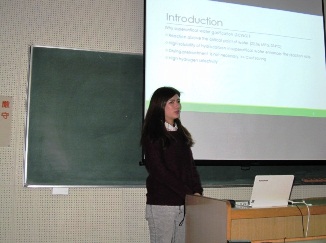On Dec 12, 2013, the 15th Biomass Evening Seminar was held at Graduate School of Engineering, Hiroshima University.
Biomass Project Research Center, Hiroshima University, and HOSTY Association are co-organizing the Hiroshima University Biomass Evening Seminar. This seminar covers topics from the fundamentals of biomass to the latest information so that it can contribute the activities on biomass in this district.
- Date & Time:
Thu., Dec.20, 2013 16:20 - 17:50 - Place:
Engineering 110 Lecture Room, Higashi-Hiroshima Campus, Hiroshima University
[Program]
- Commentary:
Yukihiko MATSUMURA
Professor, Institute of Engineering, Hiroshima University
- Chair:
Machi KANNA
Assistant Professor, Institute of Engineering, Hiroshima University
- Lecture:
Takahisa TAJIMA
Assistant professor, Graduate School of Advanced Sciences of Matter, Hiroshima University
"Efficient bio-conversion by"Simple biocatalysts" using psychrophilic bacterial cells"
|
"Simple biocatalysts" are innovative biocatalysts which can completely convert substrates to products only by the thermo-stable enzymes expressed in bacterial cells. This biocatalyst is expected for effective bio-conversion because no by-products are generated by heat-treated host metabolic enzymes. We aimed to construct simple biocatalysts using psychrophilic bacterial cells as an effective bio-conversion tool which can use abundant mesophilic and thermophilic enzyme for various bio-conversion. In this seminar, I will talk about the bio-conversion from glycerol to 3-hydroxypropionaldehyde and 1,3-propanediol by simple biocatalysts. |
 |
- Lecture:
Hiroshi TSUNO
M2 Student,Graduate School of Engineering, Hiroshima University
"Co-gasification of glucose and guaiacol in supercritical water"
|
In supercritical water gasification of biomass, lignin blocks biomass from gasification. In this study, we investigated the decomposition of glucose with guaiacol, model compound of lignin, in supercritical water. The pressure was kept constant at 25 MPa. Interactive effect made char production from glucose at subcritical area and it from guaiacol at supercritical area decreased. |
 |
- Lecture:
Nattacha PAKSUNG
M1 Student,Graduate School of Engineering, Hiroshima University
"Effect of Base Catalyst Concentration on Supercritical Water Gasification of Glucose"
|
In this study, effects of base catalyst on subcritical water gasification of glucose, which was used as a model compound for cellulose, were explored using a tubular flow reactor. NaOH represented base catalyst, which was added to neutralize acidic products released by decomposition of glucose. Concentration of NaOH was varied from 0.00M (non-catalytic) to 0.05 M. The experiments were conducted with residence time of 5, 20 and 60 s at temperature and pressure of 350 ℃, 25 MPa respectively. Gas, liquid, and solid products were observed to confirm the carbon balance in the system. Composition of final product is determined and yield of glucose, fructose, 5-HMF, furfural, TOC (including acidic and other decomposition products), char, and gas were quantified to aim for kinetics calculation. First order was assumed for each reaction to consider kinetic parameters (k) and further to determine its Arrhenius behavior. All the results were discussed to elucidate the effect of base catalyst on supercritical water gasification of glucose. |
 |
[Inquiries about this article]
Graduate School of Engineering, Hiroshima University
Y.NAKASHIMA
Mail: y4naka [AT] hiroshima-u.ac.jp
(Please replace [AT] with @)

 Home
Home